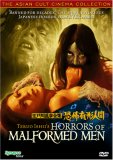My very first horror film book, acquired in Grade 3, was Denis Gifford’s A Pictorial History of Horror Movies. Among its many stills were a number for films identified by title, but with no other information provided. The result was rather tantalizing. One of those stills was for a 1969 Japanese ditty called Horror of Malformed Men. At long last, thanks to a new release from Synapse (with the title pluralized to Horrors of Malformed Men), my curiosity has been more than satisfied.
All right, seekers of the bizarre, try this plot on for size. The film opens with a man trapped in a cell with dozens of half-naked women. They’re all writhing about as if they’re performing some kind of avant-garde dance number, except for the one who is going after the guy with a knife. Eventually a guard intervenes and he hauls out the man (Teruo Yoshida), blaming him for the ruckus. Turns out the setting is an asylum, and Yoshida is an inmate, with no recollection of how or why he is there. After surviving an equally mysterious assassination attempt, Yoshida escapes. By chance (it seems), he runs into a circus performer who sings the same song that haunts Yoshida’s fragmented memories. She might have information about who he is and where he comes from, but she is killed before she can tell all. Yoshida is blamed for the murder, and he becomes a fugitive. On the run, he reads about the death of the scion of a respected family, a man who could be his twin. Yoshida takes the place of the corpse (!) and fakes a resurrection. He enters the man’s household, hoping to find out who he is, why the dead man is his exact double, and how that man really died.
So far, so bizarre, and that’s only the set-up. But where, you might ask, are the malformed men and their horrors? They show up soon enough, and once Yoshida and the fractious household relocate to a remote island owned by the dead man’s father, all hell breaks loose at both narrative and cinematic levels. “Delirium” is a sorely inadequate word to describe what happens, as the film becomes a non-stop parade of grotesquerie. The “freaks” on display are actually dancers in bizarre, pasty make-up that, while patently obvious, is still plenty disturbing in its design. When the various mysteries are finally resolved, the situation is even more bizarre than before, as if that were possible.
*******SPOILER ALERT*******SPOILER ALERT*******
I won’t go into the aforementioned solutions. They’re so insanely convoluted that explaining them would be tantamount to transcribing the screenplay. But I have to mention the ending, as it consists of one of the most demented sequences I have ever seen. Ever. Yoshida and his lover, having discovered that they are half-siblings, decide to commit suicide by fireworks mortar. We then see fireworks light up the sky, and have a brief (clumsy) glimpse of the lovers’ entwined bodies in mid air before they blow apart. Cue shots of individual body parts flying hither and thither – a head here, severed arms still holding hands there – while echoing voices call for their mother. Sunset. Fade to black. GENIUS!
*******************END SPOILER********************
The film is based on the work of writer Edogawa Rampo (his pen-name being transliteration of “Edgar Allan Poe”), whom the liner notes describe as “the master of ‘erotic-grotesque nonsense.’” Now, I haven’t read of the man’s tales, but if ever a film could embody “erotic-grotesque nonsense,” this is it. And I mean that as a term of the most extreme praise. This is a brain blaster of the very highest order. Not to be missed on pain of death.


